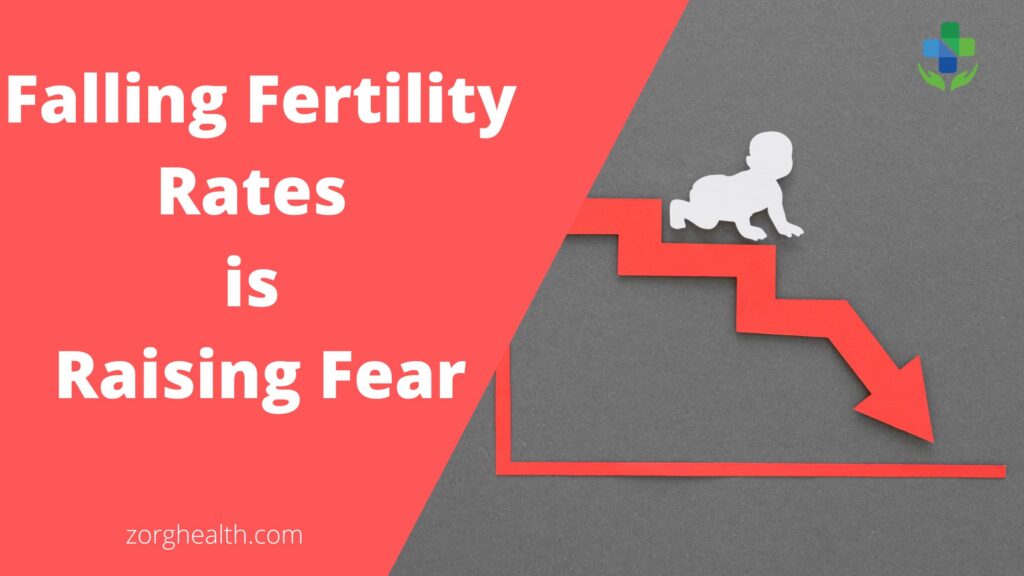Most of the world is now experiencing a transition into a global population decline. Here are some of the top world news headlines reinforcing the global demographic shift.

“India’s Fertility Rate falls below replacement level. India’s population will start to shrink sooner than expected.”
“More Americans not planning to have kids.”
“Chinese birth rate falls to a new low.”
“South Korea is struggling with a decline in childbirth.”
“Italy is expected to see a dramatic population crash.”
“Japan’s population is projected to fall significantly.”
Falling Fertility Rates – TOC
Falling Fertility Rates What does it mean?
The global Total Fertility Rates i.e the average number of children a woman gives birth to are falling.
There’s a lot of concern about why today’s young adults aren’t having as many children. Dropping fertility rates mean nearly every country could have shrinking populations by the end of the century. The world is ill-prepared for the global crash in children being born. This can trigger a “jaw-dropping” impact on societies.
The fertility rate is related to many major issues of the day — including immigration, education, housing, the labor supply, the social safety net, etc.
Why Fertility Rates are falling?
- The importance of population control has gone up
- Awareness of education of women has increased
- More girls are going to schools and colleges
- High living costs and related financial concerns on child care and education
- Women having medical issues
- Use of modern contraceptive methods and increased use of long-acting birth control methods like IUDs
- The use of condoms has increased over time
- Female sterilization has gone up. The male sterilization uptake is slow.
- Active investment and involvement of women in family planning. Men continue to take limited responsibilities
- Introduction of new reversible spacing (gaps between children) methods
- Promotion of small family norms
- Full immunization among infants/children has gone up
- Antenatal visits received by women by a health care provider have gone up
- Institutional births have increased
- Stress on women’s empowerment
- Delayed marriages for women
- Investment in maternal and child health improvement has increased
- More financially independent women have decided to embrace a single, childless lifestyle or consider adoption
- Not having partners to raise a child
Worldwide Examples – Falling Fertility Rates
China
The country`s official statistics show China`s birth rate fell to its lowest point in more than four decades last year posing a challenge for the world’s second-biggest economy.
But the falling birth rate is raising fears of a smaller working-age population having to support a bigger, retired population.
To slow population growth in China, in 1979, the Chinese government introduced a nationwide “one-child policy” with various exceptions. Families that violated the rules faced fines, loss of employment, and sometimes forced abortions.
To reverse the trend, easing the much-criticized one-child policy, in 2015, the government ended its one-child policy allowing couples to have two children. To encourage childbirth, China’s effort’s to promote childbirth were expedited from relaxing limits on having children, to easing costs associated with education and child-rearing, and introducing mandatory “cooling off” periods for divorces.
However, China’s population has become used to having just one child. Despite the policy changes they can’t afford more than one child or they don’t want a second or third child.
India
As per the latest National Family Health Survey (NFHS), the Total fertility rate—the average number of children that an Indian woman can expect to bear in her lifetime—has fallen below 2.0 for the first time.
For a long one of the main agendas of the Centre and the state governments has been to control India’s booming population. The launch of a nationwide national-level family planning program and other maternal and child health improvement programs are the key success factors behind such encouraging results. The latest data also show significant progress on several indicators related to fertility, family planning, age at marriage, and women’s empowerment — all of which have contributed to the decrease in TFR.
Although India’s overall population size will not shrink immediately, however, it seems a definite indicator of the stability of the population in the long term in the country.
South Korea
According to a 2021 statistics report on South Korean births and deaths released by the South Korean government, South Korea’s fertility rate hit rock-bottom of 0.84 babies per South Korean woman this year.
South Korea is struggling with a decline in childbirths as many young people delay or give up getting married due to difficulties in finding decent jobs or buying homes amid a prolonged economic slowdown.
The traditional preference for male children has continued to decline.
United States
Like the rest of the industrialized world, the United States also seems to join the trend of low fertility figures. The polls and surveys show that Americans are having fewer babies. They don’t plan to have any children in the future. Many simply don’t want to have kids.
44% of American adults say they don’t want a child because the future seems too bleak as the US experiences the biggest decline in births since 1973.
Due to the COVID-19 pandemic, the birth rates dropped further in the U.S., which was already at a record low before the pandemic. In a recent study by the Pew Research Center, the data suggests that pandemic-induced anxiety could have contributed to more women delaying pregnancies.
Studies are also showing a merging pattern, one of the biggest factors was personal: having no desire for children and wanting more leisure time as well as general unease about the future, maybe shifting how women feel about having children.
The Bottom Line
The world is experiencing population momentum as a result of a demographic transition.
The fertility rates are also decreasing due to public health and economic crisis caused by the coronavirus pandemic Pandemic-related worries about finances and job stability, and uncertainty about the future, and maybe shift how women feel about having children. Despite the stereotype that every woman wants a house full of kids, many people world side is deciding not to bring a baby into the world.
Most of the world will need significant economic, social, and cultural transformations to sustain economic development, provide greater social welfare, mitigate socioeconomic inequality, and ensure a suitable quality of life for the elderly.
We need to invest more in family planning, focus on interventionist policies on childbirth, need to educate women’s children to give them the best opportunities to compete in an increasingly unequal environment.
We need a swathe of policies seeking to reverse the trend and deal with the looming demographic crisis.
